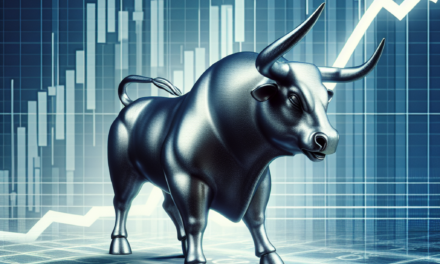“Riding the Waves: Navigating the S&P 500’s Future After Valuation Peaks”
Introduction
When the valuation of the S&P 500 surges, historical patterns and trends offer insights into potential future market behavior. Historically, elevated valuations often signal a period of heightened investor optimism and can precede various market outcomes. While high valuations have sometimes led to continued growth driven by strong economic fundamentals or technological advancements, they have also been precursors to market corrections or periods of volatility, especially if driven by speculative excesses. Analysts often examine metrics such as the price-to-earnings (P/E) ratio, historical performance during similar valuation peaks, and macroeconomic conditions to forecast potential trajectories. Understanding these historical precedents can help investors gauge the likelihood of sustained growth versus the risk of a market downturn, providing a framework for strategic decision-making in the face of valuation surges.
Historical Patterns: S&P 500 Performance Post-Valuation Peaks
The S&P 500, a benchmark index representing the performance of 500 leading publicly traded companies in the United States, has long been a barometer for the health of the U.S. stock market and, by extension, the economy. When the valuation of the S&P 500 surges, it often prompts investors and analysts to speculate about the future trajectory of the market. Historical patterns provide valuable insights into how the index has performed following periods of elevated valuations, offering a lens through which we can attempt to predict future movements.
Historically, the S&P 500 has experienced several notable periods of valuation surges, often measured by metrics such as the price-to-earnings (P/E) ratio. These surges have typically been followed by a range of outcomes, influenced by a variety of economic, political, and social factors. For instance, the late 1990s saw a dramatic increase in valuations during the dot-com bubble, driven by investor enthusiasm for technology stocks. This period was characterized by a P/E ratio that soared well above historical averages. However, the subsequent market correction in the early 2000s serves as a cautionary tale of how inflated valuations can lead to significant downturns.
In contrast, the post-financial crisis recovery of the 2010s presented a different scenario. Valuations rose steadily as the economy recovered, supported by low interest rates and quantitative easing measures. During this time, the S&P 500 experienced a prolonged bull market, suggesting that elevated valuations do not always precipitate immediate declines. Instead, they can be sustained over longer periods, particularly when supported by favorable economic conditions and investor sentiment.
Moreover, examining the aftermath of valuation peaks requires consideration of external factors that can influence market performance. For example, geopolitical events, changes in monetary policy, and shifts in consumer behavior can all play pivotal roles in determining the direction of the market. The COVID-19 pandemic, for instance, introduced unprecedented volatility and uncertainty, yet the S&P 500 rebounded swiftly after an initial downturn, driven by rapid fiscal and monetary interventions.
Another important aspect to consider is the role of investor psychology. During periods of high valuations, investor behavior can be driven by a mix of fear and greed, leading to increased volatility. The fear of missing out (FOMO) can propel markets higher, while sudden shifts in sentiment can trigger sharp corrections. Understanding these psychological dynamics is crucial for interpreting historical patterns and anticipating future movements.
Furthermore, it is essential to recognize that while history provides valuable lessons, it is not a definitive predictor of future outcomes. Each valuation surge occurs within a unique context, shaped by the prevailing economic environment and market dynamics. Therefore, while historical patterns can offer guidance, they should be considered alongside other analytical tools and indicators.
In conclusion, the performance of the S&P 500 following valuation peaks is influenced by a complex interplay of historical precedents, economic conditions, and investor behavior. While past patterns suggest that elevated valuations can lead to both sustained growth and significant corrections, the specific outcome in any given period will depend on a multitude of factors. As such, investors should approach predictions with caution, remaining vigilant to the ever-evolving landscape of the financial markets.
Lessons from the Past: S&P 500 Trends After Market Surges
The S&P 500, a benchmark index representing the performance of 500 leading publicly traded companies in the United States, has long been a barometer for the health of the U.S. stock market and, by extension, the economy. When the valuation of the S&P 500 surges, it often prompts investors and analysts to speculate about the future trajectory of the market. Historical trends provide valuable insights into what might be expected following such surges, offering lessons that can guide investment strategies.
Historically, significant increases in the valuation of the S&P 500 have been followed by a variety of market behaviors. One common pattern observed is the eventual correction or stabilization of prices. This phenomenon can be attributed to the market’s self-correcting nature, where overvaluation is often followed by a period of adjustment. For instance, during the late 1990s, the dot-com bubble led to a dramatic rise in the S&P 500, driven by speculative investments in technology stocks. However, this surge was unsustainable, and the market eventually corrected itself in the early 2000s, leading to a significant downturn.
Moreover, historical data suggests that after periods of rapid valuation increases, the S&P 500 often experiences heightened volatility. This volatility can be attributed to investor uncertainty and the reevaluation of asset prices. For example, following the financial crisis of 2008, the S&P 500 saw a substantial recovery, but this was accompanied by fluctuations as investors grappled with the implications of economic recovery and policy changes. Such volatility can present both risks and opportunities for investors, emphasizing the importance of a well-considered investment strategy.
In addition to corrections and volatility, another trend observed after valuation surges is the potential for prolonged periods of moderate returns. When the market experiences a rapid increase in valuation, it often leads to elevated price-to-earnings ratios, which can result in more subdued returns in the subsequent years. This was evident in the aftermath of the 1987 market crash, where the S&P 500 took several years to regain its previous highs, and returns were relatively modest during the recovery phase.
Furthermore, it is essential to consider the broader economic context when evaluating the implications of a valuation surge. Factors such as interest rates, inflation, and fiscal policies play a crucial role in shaping market outcomes. For instance, during periods of low interest rates, as seen in the years following the 2008 financial crisis, the S&P 500 benefited from an influx of capital seeking higher returns, contributing to sustained growth despite initial volatility.
While history provides valuable lessons, it is important to recognize that past performance is not always indicative of future results. Each market surge is influenced by unique circumstances, and the interplay of various economic factors can lead to different outcomes. Therefore, investors should approach historical trends with a critical eye, using them as one of many tools in their decision-making process.
In conclusion, the history of the S&P 500 following valuation surges offers several key insights: the likelihood of market corrections, increased volatility, and the potential for moderate returns. By understanding these patterns and considering the broader economic context, investors can better navigate the complexities of the market and make informed decisions. As always, a diversified portfolio and a long-term perspective remain essential components of a successful investment strategy.
Analyzing Historical Data: S&P 500 Reactions to High Valuations
The S&P 500, a benchmark index representing the performance of 500 leading publicly traded companies in the United States, has long been a barometer for the overall health of the stock market. Investors and analysts alike often scrutinize its valuation levels to gauge future market trends. Historically, periods of high valuations have sparked debates about potential market corrections or sustained growth. By examining historical data, we can gain insights into how the S&P 500 has reacted to elevated valuations in the past and what this might suggest for future market behavior.
To begin with, it is essential to understand what constitutes a high valuation. Typically, this is measured using the price-to-earnings (P/E) ratio, which compares a company’s share price to its earnings per share. A high P/E ratio may indicate that stocks are overvalued, as investors are willing to pay more for each dollar of earnings. Historically, when the S&P 500 has reached elevated P/E ratios, it has often been followed by periods of volatility. For instance, during the late 1990s, the index experienced a significant surge in valuations, culminating in the dot-com bubble. This period was characterized by exuberant investor sentiment and speculative investments in technology stocks, which eventually led to a sharp market correction in the early 2000s.
However, it is crucial to note that high valuations do not always result in immediate downturns. In some cases, they have been followed by continued growth, driven by strong economic fundamentals and corporate earnings. For example, in the years following the 2008 financial crisis, the S&P 500 experienced a prolonged bull market despite rising valuations. This growth was supported by accommodative monetary policies, low interest rates, and robust corporate performance, which helped sustain investor confidence.
Moreover, historical data suggests that the context in which high valuations occur plays a significant role in determining subsequent market movements. During periods of economic expansion, high valuations may be justified by expectations of future earnings growth. Conversely, in times of economic uncertainty or geopolitical tensions, elevated valuations may be perceived as unsustainable, leading to increased market volatility. Therefore, it is essential for investors to consider the broader economic environment when assessing the implications of high valuations.
Another factor to consider is the role of investor sentiment. Historically, market psychology has had a profound impact on the S&P 500’s performance following valuation surges. During periods of optimism, investors may be more willing to overlook high valuations, driving prices even higher. Conversely, during times of fear or uncertainty, high valuations can exacerbate market sell-offs as investors rush to lock in profits or minimize losses.
In conclusion, while historical data provides valuable insights into the S&P 500’s reactions to high valuations, it is important to recognize that past performance is not always indicative of future results. The interplay of economic conditions, corporate earnings, and investor sentiment can all influence how the market responds to elevated valuations. As such, investors should approach high valuations with a nuanced perspective, considering both historical trends and current market dynamics. By doing so, they can make more informed decisions and better navigate the complexities of the stock market.
Predictive Insights: S&P 500 Movements Following Valuation Spikes

The S&P 500, a benchmark index representing the performance of 500 leading publicly traded companies in the United States, has long been a barometer for the overall health of the stock market and the economy. When the valuation of the S&P 500 surges, it often prompts investors and analysts to speculate about the future trajectory of the market. Historical patterns provide valuable insights into how the index might behave following such valuation spikes, offering a glimpse into potential future movements.
Historically, significant surges in the valuation of the S&P 500 have been followed by a variety of market behaviors, influenced by a complex interplay of economic factors, investor sentiment, and external events. One of the key metrics used to assess the valuation of the S&P 500 is the price-to-earnings (P/E) ratio, which compares the index’s current price to its earnings per share. When this ratio climbs significantly above its historical average, it often signals that the market may be overvalued, leading to concerns about a potential correction.
Looking back at past instances of valuation spikes, it becomes evident that the S&P 500’s subsequent performance can vary widely. For example, during the late 1990s, the index experienced a dramatic increase in valuation, driven by the dot-com boom. This period was characterized by exuberant investor sentiment and a belief in the transformative potential of technology companies. However, the subsequent bursting of the dot-com bubble led to a sharp decline in the index, underscoring the risks associated with high valuations.
Conversely, there have been instances where high valuations did not immediately lead to a downturn. In the years following the 2008 financial crisis, the S&P 500 experienced a prolonged period of rising valuations, supported by low interest rates and quantitative easing measures implemented by central banks. During this time, the index continued to climb, defying predictions of an imminent correction. This suggests that while high valuations can be a warning sign, they do not necessarily guarantee an immediate reversal.
Moreover, the context in which a valuation surge occurs plays a crucial role in determining the S&P 500’s future movements. Economic conditions, such as GDP growth, inflation rates, and employment levels, can either support or undermine high valuations. For instance, a robust economic environment with strong corporate earnings growth may justify elevated valuations, reducing the likelihood of a sharp correction. On the other hand, if high valuations coincide with economic uncertainty or geopolitical tensions, the risk of a downturn may increase.
Investor sentiment also plays a pivotal role in shaping the market’s response to valuation spikes. During periods of optimism, investors may be more willing to overlook high valuations, driving prices even higher. However, if sentiment shifts and fear takes hold, the market may experience heightened volatility and a potential correction. This dynamic underscores the importance of monitoring not only economic indicators but also the psychological factors influencing market behavior.
In conclusion, while history provides valuable insights into the potential movements of the S&P 500 following valuation surges, it is essential to recognize the multifaceted nature of the market. High valuations can signal potential risks, but they do not operate in isolation. Economic conditions, investor sentiment, and external events all contribute to shaping the index’s future trajectory. Therefore, investors should approach valuation spikes with a nuanced understanding, considering both historical patterns and current market dynamics to make informed decisions.
Market Cycles: S&P 500 Behavior After Valuation Increases
The S&P 500, a benchmark index representing the performance of 500 leading publicly traded companies in the United States, has long been a barometer for the health of the U.S. stock market and, by extension, the economy. When valuations surge, as they periodically do, investors and analysts alike turn to historical patterns to predict future movements. Understanding these patterns is crucial for making informed investment decisions. Historically, the S&P 500 has experienced several periods of significant valuation increases, often followed by varied market behaviors. By examining these past instances, we can glean insights into potential future trends.
To begin with, it is essential to recognize that valuation surges in the S&P 500 are typically driven by a combination of factors, including economic growth, corporate earnings, investor sentiment, and monetary policy. For instance, during the late 1990s, the dot-com boom led to a dramatic increase in valuations as investors poured money into technology stocks, anticipating unprecedented growth. However, this period was followed by a sharp correction in the early 2000s, as the bubble burst and valuations returned to more sustainable levels. This historical example underscores the cyclical nature of the market, where periods of exuberance are often tempered by corrections.
Moreover, the aftermath of valuation surges is not always negative. In some cases, high valuations have been sustained for extended periods, particularly when supported by strong economic fundamentals. For example, the bull market of the 1980s and 1990s saw sustained growth in the S&P 500, driven by technological advancements, globalization, and favorable monetary policies. During this time, valuations remained elevated, yet the market continued to climb, illustrating that high valuations do not necessarily presage an imminent downturn. This suggests that while corrections are a natural part of market cycles, they are not inevitable following every surge in valuations.
Furthermore, the role of monetary policy cannot be overlooked when considering the S&P 500’s behavior after valuation increases. Central banks, particularly the Federal Reserve, play a pivotal role in shaping market dynamics through interest rate adjustments and other monetary tools. In periods of low interest rates, equities often become more attractive as investors seek higher returns, leading to increased valuations. However, when interest rates rise, as they often do in response to inflationary pressures, the cost of borrowing increases, potentially dampening corporate profits and investor enthusiasm. This interplay between monetary policy and market valuations is a critical factor in predicting future market behavior.
In addition to these economic factors, investor psychology also plays a significant role in shaping the S&P 500’s trajectory after valuation surges. Behavioral finance suggests that investor sentiment can drive markets to irrational highs or lows, often resulting in volatility. During periods of high valuations, fear of missing out (FOMO) can lead to increased buying, further inflating prices. Conversely, when valuations appear unsustainable, fear and uncertainty can trigger sell-offs, leading to market corrections. Understanding these psychological dynamics is essential for anticipating potential market movements.
In conclusion, while history provides valuable insights into the S&P 500’s behavior following valuation surges, it is important to recognize that each market cycle is unique, influenced by a myriad of factors. By considering historical patterns alongside current economic conditions, monetary policy, and investor sentiment, investors can better navigate the complexities of the market and make informed decisions. Ultimately, while past performance is not a guarantee of future results, it remains a crucial tool for understanding potential market trajectories.
Historical Comparisons: S&P 500 Outcomes Post-Valuation Surges
The S&P 500, a benchmark index representing the performance of 500 leading publicly traded companies in the United States, has long been a barometer for the health of the U.S. stock market and, by extension, the economy. When the valuation of the S&P 500 surges, it often prompts investors and analysts to speculate about the future trajectory of the market. Historical comparisons provide valuable insights into what might be expected following such valuation surges, offering a lens through which to view potential outcomes.
To understand the implications of a valuation surge, it is essential to consider the historical context. Historically, periods of rapid valuation increases in the S&P 500 have been followed by a variety of outcomes, ranging from continued growth to significant corrections. For instance, the late 1990s saw a dramatic rise in valuations during the dot-com bubble, driven by investor enthusiasm for technology stocks. This period was characterized by a speculative frenzy, which ultimately culminated in a sharp market correction in the early 2000s. The lessons from this era underscore the potential risks associated with valuation surges, particularly when they are not supported by corresponding earnings growth.
Conversely, there have been instances where valuation surges have been followed by sustained growth. The post-financial crisis recovery in the 2010s, for example, saw the S&P 500 experience significant valuation increases. This period was marked by a combination of low interest rates, accommodative monetary policy, and improving corporate earnings, which collectively supported the market’s upward trajectory. The key takeaway from this period is that valuation surges, when underpinned by strong economic fundamentals, can lead to prolonged periods of market expansion.
Moreover, examining the role of external factors is crucial in understanding the outcomes following valuation surges. Geopolitical events, changes in fiscal policy, and shifts in investor sentiment can all influence the market’s direction. For instance, the early 1980s witnessed a surge in valuations as the U.S. economy emerged from a period of stagflation. The subsequent bull market was fueled by a combination of tax cuts, deregulation, and a decline in interest rates, illustrating how policy changes can significantly impact market dynamics.
In addition to these factors, investor psychology plays a pivotal role in shaping market outcomes. During periods of valuation surges, investor optimism can lead to overvaluation, as seen in the exuberance of the late 1990s. However, when optimism is tempered by caution and a focus on fundamentals, the market can experience more sustainable growth. This delicate balance between fear and greed often dictates the market’s path following a valuation surge.
In conclusion, while history does not provide a definitive roadmap for the future, it offers valuable lessons that can guide investors in navigating periods of valuation surges. By examining past instances, it becomes evident that the outcomes are influenced by a confluence of factors, including economic fundamentals, external events, and investor behavior. As such, a nuanced understanding of these elements is essential for anticipating the potential trajectories of the S&P 500 following a surge in valuations. Ultimately, while the past may not predict the future with certainty, it equips investors with the knowledge to make informed decisions in an ever-evolving market landscape.
Learning from History: S&P 500 Trends After Valuation Highs
The S&P 500, a benchmark index representing the performance of 500 leading publicly traded companies in the United States, has long been a barometer for the health of the U.S. stock market and, by extension, the economy. When valuations surge, as they have in various periods throughout history, investors and analysts alike turn to historical trends to predict future movements. Understanding these patterns is crucial for making informed investment decisions.
Historically, periods of high valuations in the S&P 500 have often been followed by a range of outcomes, influenced by a myriad of factors including economic conditions, interest rates, and investor sentiment. For instance, during the late 1990s, the dot-com bubble saw valuations reach unprecedented levels. The subsequent market correction in the early 2000s serves as a stark reminder of the potential volatility following such surges. However, it is essential to note that not all high-valuation periods result in dramatic downturns. The context in which these valuations occur plays a significant role in determining the market’s trajectory.
Transitioning to another historical example, the period leading up to the 2008 financial crisis also witnessed elevated valuations, driven by a housing market boom and financial innovations that masked underlying risks. The ensuing crash was severe, but it was not solely the result of high valuations; rather, it was the culmination of systemic issues within the financial system. This highlights the importance of considering broader economic indicators alongside valuation metrics when predicting future trends.
In contrast, the post-2008 recovery period saw valuations rise steadily, supported by low interest rates and quantitative easing measures implemented by the Federal Reserve. This environment fostered a prolonged bull market, demonstrating that high valuations can be sustained over time when supported by accommodative monetary policy and robust economic growth. Thus, while history provides valuable insights, it also underscores the complexity of predicting market movements based solely on valuation levels.
Moreover, the role of technological advancements and globalization in shaping market dynamics cannot be overlooked. The rapid pace of innovation and the integration of global markets have introduced new variables that were not present in earlier high-valuation periods. These factors can contribute to sustained growth, as seen in the recent surge in technology stocks, which have driven much of the S&P 500’s performance in recent years. Consequently, investors must consider these modern influences when drawing parallels with historical trends.
Furthermore, investor behavior and sentiment play a crucial role in determining market outcomes following valuation surges. Behavioral finance suggests that psychological factors, such as fear and greed, can exacerbate market movements, leading to overreactions in both directions. Understanding these dynamics can provide additional context for interpreting historical patterns and anticipating future trends.
In conclusion, while history offers valuable lessons on the potential outcomes following valuation surges in the S&P 500, it is not a definitive predictor of future performance. The interplay of economic conditions, monetary policy, technological advancements, and investor behavior all contribute to the complexity of the market landscape. Therefore, a comprehensive analysis that considers both historical trends and contemporary factors is essential for making informed investment decisions in the face of high valuations. As investors navigate these uncertain waters, a nuanced understanding of history, combined with a keen awareness of current developments, will be indispensable in anticipating the S&P 500’s future trajectory.
Q&A
1. **Question:** What historical trend is observed when the S&P 500’s valuation surges?
– **Answer:** Historically, when the S&P 500’s valuation surges, it often leads to a period of lower future returns as valuations revert to more average levels.
2. **Question:** How does a high valuation impact future stock market returns according to historical data?
– **Answer:** High valuations have historically been associated with lower future stock market returns, as the market may be overvalued and due for a correction or period of stagnation.
3. **Question:** What role do interest rates play in the S&P 500’s valuation trends?
– **Answer:** Historically, lower interest rates have supported higher valuations by making equities more attractive compared to bonds, while rising rates can pressure valuations downward.
4. **Question:** How have past valuation surges in the S&P 500 affected market volatility?
– **Answer:** Past valuation surges have often been followed by increased market volatility, as corrections or adjustments occur when valuations are perceived as unsustainable.
5. **Question:** What is the historical relationship between S&P 500 valuation surges and economic recessions?
– **Answer:** Historically, significant valuation surges have sometimes preceded economic recessions, as overvaluation can lead to market corrections that coincide with economic downturns.
6. **Question:** How do valuation surges impact investor sentiment and behavior?
– **Answer:** Valuation surges can lead to increased investor optimism and risk-taking, but they can also result in caution and profit-taking if investors anticipate a correction.
7. **Question:** What historical patterns are observed in the S&P 500 following a valuation surge?
– **Answer:** Following a valuation surge, the S&P 500 has historically experienced periods of consolidation or decline as valuations adjust, though the timing and magnitude can vary.
Conclusion
Historically, when the S&P 500 experiences a surge in valuation, it often leads to a period of increased volatility and potential market corrections. Elevated valuations can indicate overbought conditions, suggesting that future returns may be lower than average as the market adjusts. However, the timing and magnitude of any correction are uncertain, as market dynamics are influenced by various factors, including economic conditions, interest rates, and investor sentiment. While past patterns suggest caution, they do not guarantee future outcomes, and investors should consider a diversified approach and long-term perspective.





